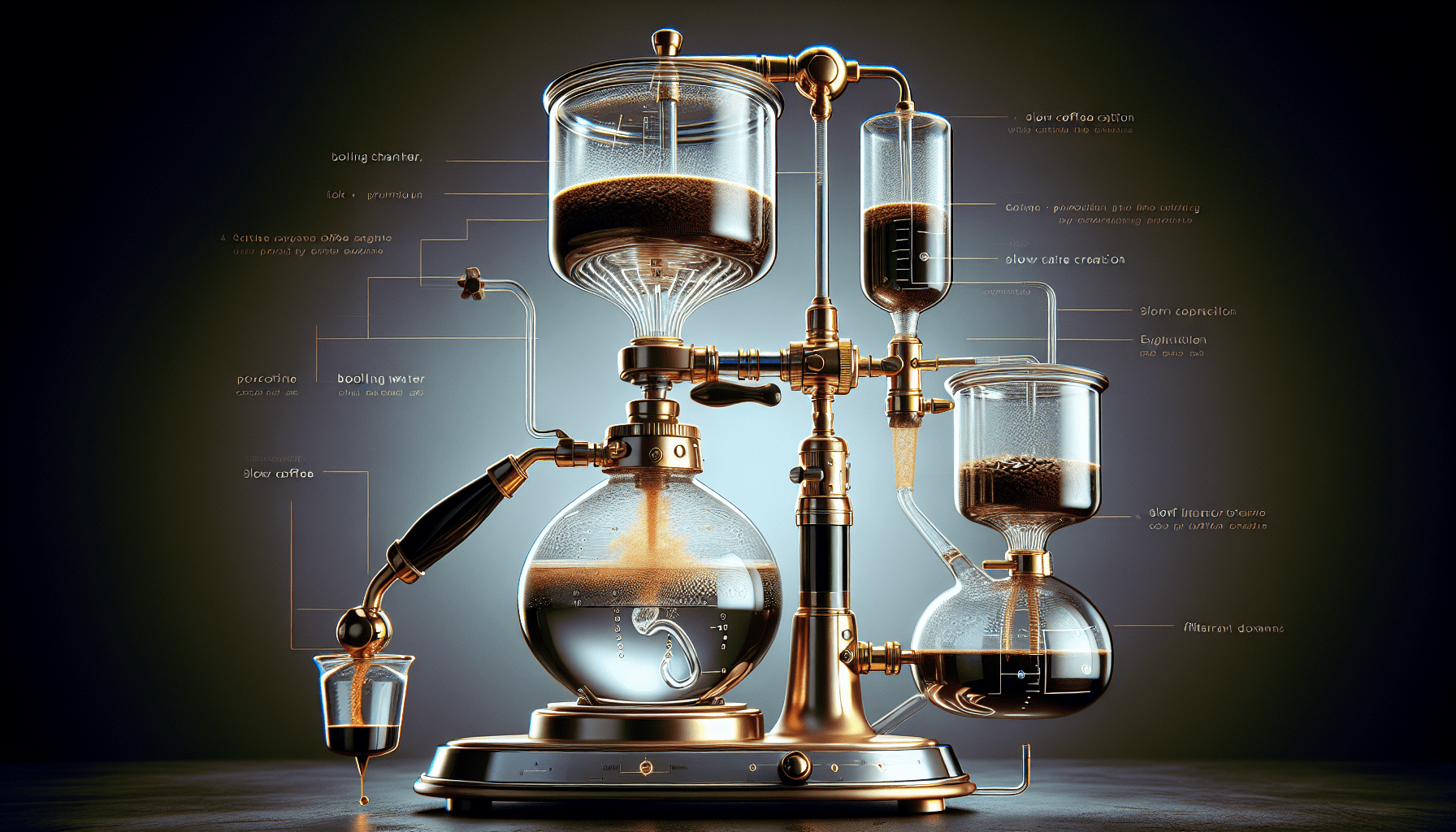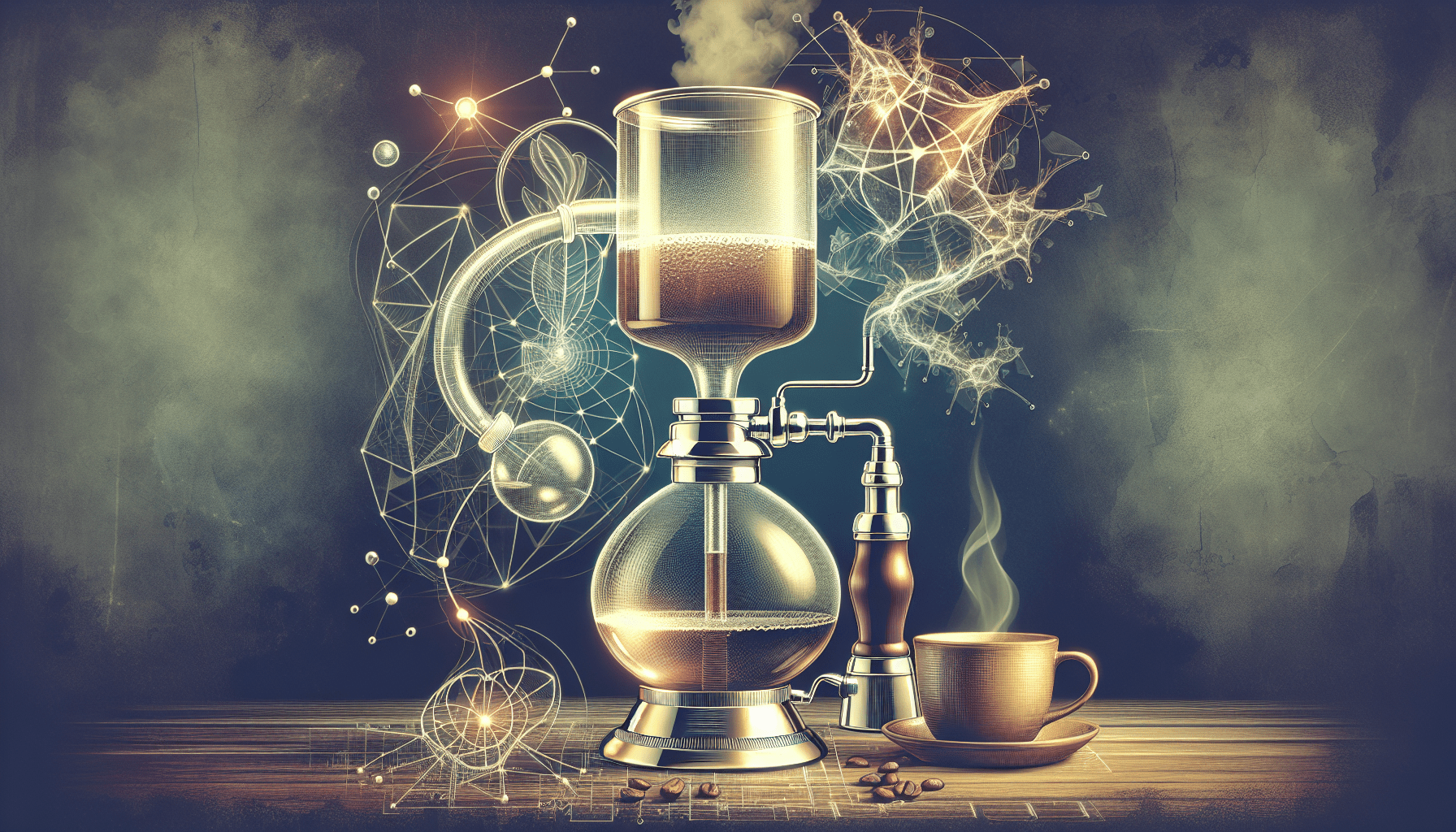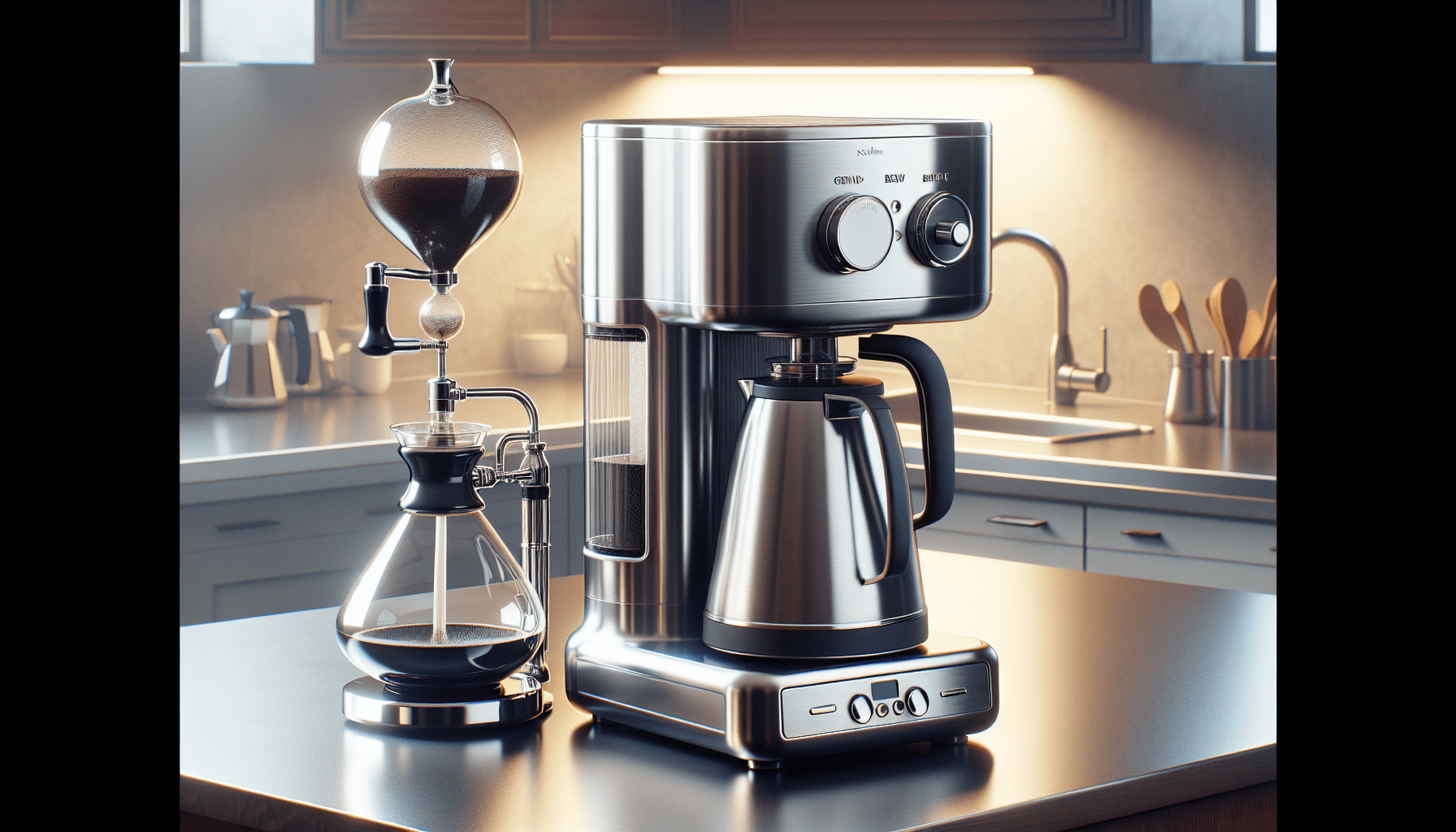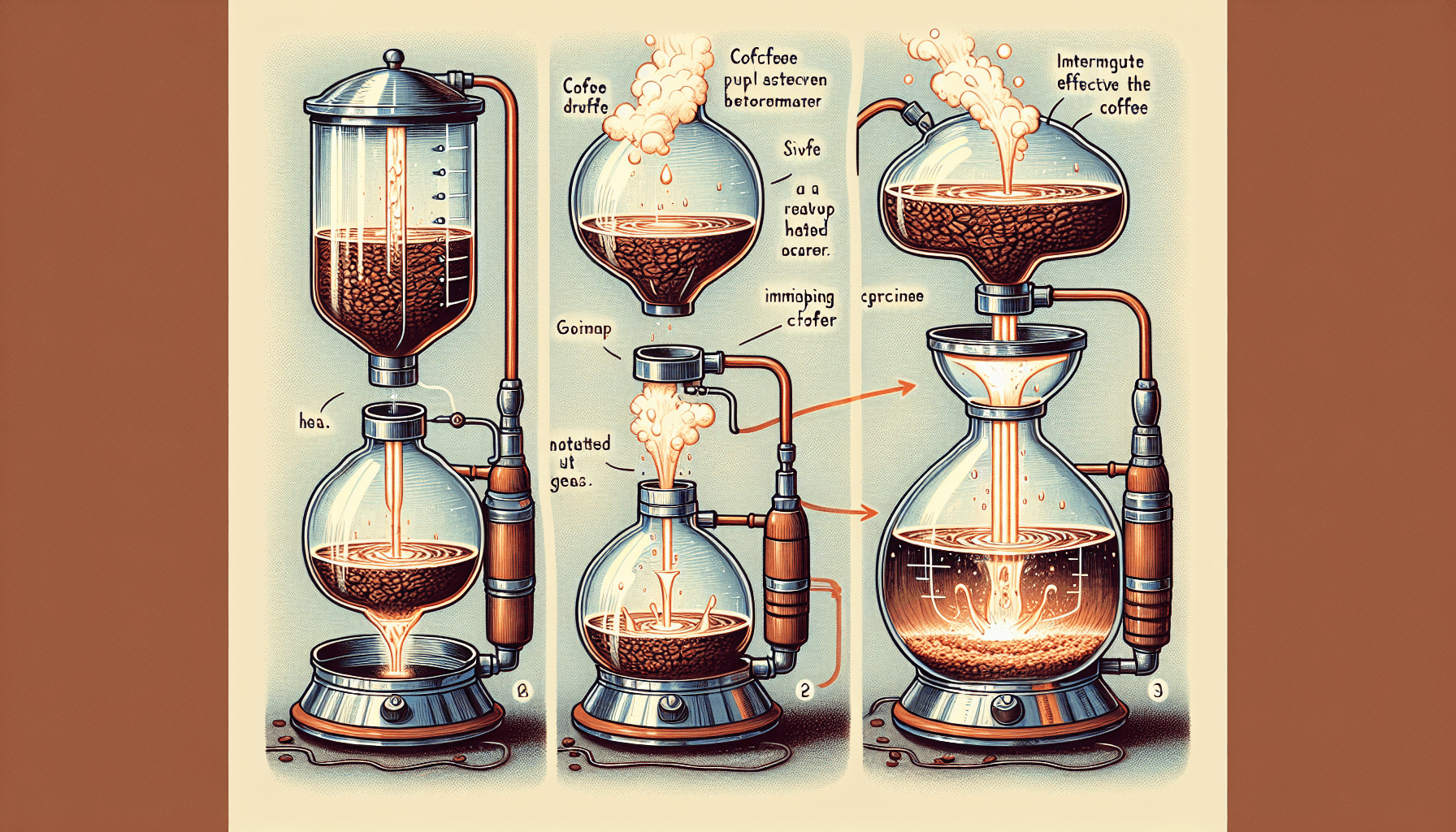Do you ever wonder how your favorite cup of coffee is made? Well, when it comes to brewing methods, there are countless options to choose from, each offering its own unique flavors and aromas. In this article, we will explore the difference between a siphon coffee maker and other popular brewing methods. Whether you’re a coffee aficionado looking to try something new or simply curious about the science behind your morning brew, this article will help unravel the mystery and reveal the distinct characteristics of siphon coffee making. So grab a fresh cup of your preferred blend and let’s embark on this flavorful journey together!
Brewing Methods
When it comes to brewing coffee, there are several popular methods to choose from. Each method has its own unique characteristics and can result in different flavors and aromas. Here, we will explore some of the most common brewing methods, including drip brewing, French press, espresso, pour-over, and cold brew.
Drip Brewing
Drip brewing is one of the most commonly used methods for making coffee. It involves pouring hot water over a bed of coffee grounds, which are held in a paper or metal filter. The water then passes through the filter and flows into a pot or carafe, resulting in a smooth and clean cup of coffee. Drip brewing is known for its simplicity and convenience, making it a popular choice for everyday coffee drinkers.
French Press
The French press, also known as a press pot or plunger pot, is a classic brewing method that has been used for centuries. It involves steeping coffee grounds in hot water and then pressing a plunger or mesh filter down to separate the liquid from the grounds. This method allows for full immersion of the coffee, resulting in a rich and bold flavor. French press coffee is loved by many for its full-bodied taste and the ability to control the strength of the brew.
Espresso
Espresso is a brewing method that originated in Italy and is loved for its concentrated and intense flavor. It involves forcing pressurized hot water through finely ground coffee, which is tightly packed into a portafilter. The water passes through the coffee under high pressure, resulting in a small and concentrated shot of coffee. Espresso is the base for many popular coffee drinks, such as lattes and cappuccinos, and is known for its strong and bold flavor profile.
Pour-over
Pour-over brewing is a method that involves pouring hot water over coffee grounds in a slow and steady manner. This allows for precise control over the brewing process, resulting in a well-extracted and flavorful cup of coffee. Pour-over brewing is often done using a cone-shaped dripper, such as a Hario V60 or a Chemex, which allows for the extraction of the coffee’s flavors to shine through. This method is favored by coffee enthusiasts for its ability to highlight the nuances of different coffee beans.
Cold Brew
Cold brew is a brewing method that involves steeping coffee grounds in cold water for an extended period of time, typically around 12 to 24 hours. This slow extraction process results in a smooth and less acidic cup of coffee, which is often served over ice. Cold brew is known for its refreshing taste and is a popular choice for those who prefer a milder and less bitter coffee flavor.
Understanding Siphon Coffee Maker
Now that we have explored some of the common brewing methods, let’s focus on understanding the siphon coffee maker. The siphon, also known as a vacuum coffee maker or vacuum pot, has a unique and intriguing design that sets it apart from other brewing methods.
Concept and Design
The siphon coffee maker consists of two chambers – a bottom chamber, also known as the lower bowl or carafe, and a top chamber, also known as the upper bowl or brewing chamber. These two chambers are connected by a tube, which allows the coffee to be brewed through a siphoning process. The siphon coffee maker operates on the principle of vapor pressure and vacuum, creating a visually captivating brewing process.
Vacuum and Heat
One of the key elements of the siphon coffee maker is the use of heat and vacuum. The bottom chamber is filled with water, which is then heated to a specific temperature. As the water heats up, it creates steam and pressure, which pushes the water into the top chamber. Once the heat source is removed, the steam condenses, creating a vacuum that pulls the brewed coffee back into the bottom chamber, filtering it through a cloth or metal filter.
Siphoning Process
The siphoning process in a coffee maker is what sets it apart from other brewing methods. The water is brought to a boil in the bottom chamber, and as it heats up, it creates pressure that forces the water up to the top chamber. During this process, the grounds are fully immersed in the water, allowing for optimal extraction of flavors. Once the heat source is removed, the brewed coffee is pulled back down into the bottom chamber, filtering out the grounds and resulting in a clean and flavorful cup of coffee.
Key Differences
Now that we understand the concept and design of the siphon coffee maker, let’s explore the key differences between the siphon and other brewing methods. These differences include brewing temperature, flavor extraction, brewing time, brewing complexity, and aesthetics.
Brewing Temperature
The brewing temperature plays a crucial role in determining the flavor and aroma of the coffee. With drip brewing, the water temperature is typically around 195 to 205 degrees Fahrenheit (90 to 96 degrees Celsius). French press and pour-over methods also require water in the same temperature range for optimal extraction. On the other hand, espresso brewing requires water to be heated to a higher temperature of around 190 to 205 degrees Fahrenheit (88 to 96 degrees Celsius). In contrast, the siphon coffee maker allows for more precise control over the brewing temperature, typically between 195 and 205 degrees Fahrenheit (90 to 96 degrees Celsius), resulting in a flavorful and balanced cup of coffee.
Flavor Extraction
The flavor extraction process varies between different brewing methods. In a drip brewer, the water passes through a filter and drips onto the coffee grounds, resulting in a clean and smooth cup of coffee. French press brewing involves full immersion of the grounds, allowing for the extraction of oils and flavors. Espresso extraction occurs under high pressure and within a short amount of time, resulting in a concentrated and intense flavor profile. Pour-over brewing allows for precise control over the extraction, highlighting the nuanced flavors of the coffee beans. Siphon brewing, with its full immersion and vacuum filtration, ensures optimal extraction and results in a clean and pure flavor.
Brewing Time
The brewing time can vary significantly between different methods. Drip brewing typically takes around 4 to 6 minutes, depending on the amount of coffee being brewed. French press brewing requires a longer steeping time of 4 to 8 minutes, allowing for full immersion and extraction of flavors. Espresso brewing is the quickest method, with the extraction process taking only around 25 to 30 seconds. Pour-over brewing can range from 2 to 4 minutes, depending on the desired strength and flavor extraction. Siphon brewing usually takes around 3 to 5 minutes, providing enough time for the coffee to steep and extract flavors thoroughly.
Brewing Complexity
The complexity of brewing can vary between different methods, both in terms of equipment and techniques required. Drip brewing is often considered the simplest method, requiring a coffee machine, a filter, and water. French press brewing involves the use of a press pot and a plunger, requiring some manual effort and technique. Espresso brewing requires an espresso machine, a grinder, and precise control over extraction time and pressure. Pour-over brewing requires a dripper, filter, kettle, and pouring technique for optimal extraction. Siphon brewing requires a siphon coffee maker, a heat source, and careful attention to the brewing process. While it may seem more complex, siphon brewing can be an enjoyable and rewarding method for coffee enthusiasts.
Aesthetics
Apart from the taste and brewing process, the aesthetics of the coffee maker and serving presentation can also have an impact on the overall experience. Drip brewers come in various designs and sizes, ranging from simple to more elaborate models. French press brewing often showcases the elegance of the glass pot and the plunger mechanism. Espresso machines can be a statement piece in a kitchen with their sleek and stylish designs. Pour-over brewing is often appreciated for the visual appeal of the dripper and the control over the brewing process. Siphon coffee makers, with their glass chambers and unique vacuum brewing process, create a visually captivating experience that can be quite enjoyable.
Brewing Temperature
When it comes to brewing coffee, maintaining a consistent temperature throughout the brewing process is crucial to achieving optimal results. This is true for any brewing method, including the siphon coffee maker.
Consistent Heat Source
To brew a delicious cup of coffee with the siphon coffee maker, it’s important to have a consistent heat source. This can be achieved by using a butane burner, an alcohol burner, or even an electric stove. It’s essential to pay attention to the heat source and make sure it provides a steady and even heat throughout the brewing process.
Heat Distribution
In addition to a consistent heat source, heat distribution is also important in the siphon coffee maker. The bottom chamber, where the water is heated, should distribute heat evenly to ensure that the coffee grounds are steeped at the right temperature. This can be achieved by using a well-designed siphon coffee maker that allows for efficient heat transfer and distribution.
Brewing Control
One of the advantages of using a siphon coffee maker is the ability to have precise control over the brewing temperature. Unlike some other brewing methods that rely on preset temperatures, such as drip brewers or espresso machines, the siphon coffee maker allows you to adjust the heat source to achieve the desired brewing temperature. This control over temperature can result in a perfectly brewed cup of coffee that brings out the best flavors and aromas of the beans.
Flavor Extraction
Flavor extraction is a fundamental aspect of brewing coffee, and it can greatly impact the taste and quality of the final cup. When it comes to flavor extraction, the siphon coffee maker offers some unique advantages.
Full Immersion
One of the key features of the siphon coffee maker is its ability to fully immerse the coffee grounds in water. This allows for optimal extraction of flavors, as the water can come into contact with every particle of the coffee. The result is a cup of coffee that showcases the full range of flavors and nuances present in the beans.
Optimal Extraction
The siphon coffee maker’s full immersion and vacuum filtration process contribute to optimal extraction of flavors. As the water is heated and rises to the top chamber, it saturates the coffee grounds, extracting oils, acids, and other compounds that contribute to the overall taste. The vacuum filtration ensures that the brewed coffee is free from any sediment or unwanted particles, resulting in a clean and pure flavor.
Filtering
Filtering is an important step in the brewing process, as it determines the clarity and cleanliness of the final cup of coffee. In the siphon coffee maker, the coffee is filtered through a cloth or metal filter as it is pulled back into the lower chamber. This filtration process helps to remove any remaining coffee grounds or sediment, resulting in a smooth and sediment-free cup of coffee. The filtering in the siphon coffee maker ensures that the flavors are extracted while leaving behind any unwanted particles.
Brewing Time
The brewing time of a coffee method can vary and can have an impact on the strength and flavors of the brew. The siphon coffee maker offers a unique brewing time that contributes to its distinct characteristics.
Brewing Time Comparison
When comparing brewing times, drip brewing usually takes around 4 to 6 minutes, depending on the machine and the amount of coffee being brewed. French press brewing requires a longer steeping time of 4 to 8 minutes, allowing for full immersion and extraction. Espresso brewing is the quickest method, with the extraction process taking only around 25 to 30 seconds. Pour-over brewing can range from 2 to 4 minutes, depending on the desired strength and extraction. Siphon brewing usually takes around 3 to 5 minutes, providing enough time for the coffee to steep and extract fully.
Steeping and Extraction
The brewing time in the siphon coffee maker allows for an adequate steeping period, during which the coffee grounds are in contact with the hot water. This extended steeping time contributes to a more thorough extraction of flavors, resulting in a rich and robust cup of coffee. The slow and deliberate brewing process of the siphon coffee maker ensures that the flavors are fully developed and balanced.
Adjusting Brewing Time
One of the advantages of using a siphon coffee maker is the ability to adjust the brewing time. If you prefer a stronger and bolder cup of coffee, you can increase the brewing time slightly. Conversely, if you prefer a milder cup, you can shorten the brewing time. This flexibility allows you to customize the strength and flavor profile of your coffee according to your preferences.
Brewing Complexity
The complexity of the brewing process can vary between different methods, and the siphon coffee maker is no exception. Let’s explore the various aspects of brewing complexity with the siphon coffee maker.
Equipment and Setup
The siphon coffee maker requires specific equipment and setup to brew a delicious cup of coffee. This includes the siphon coffee maker itself, a heat source (such as a butane burner or alcohol burner), coffee grounds, water, and a cloth or metal filter. Setting up the siphon coffee maker and assembling the various components may initially seem complex. However, with practice and familiarity, you will become more efficient and comfortable with the process.
Technique and Skill
Brewing coffee with the siphon coffee maker requires a certain level of technique and skill. Controlling the heat source, maintaining a consistent brewing temperature, and managing the various stages of the brewing process all require attention to detail. However, with patience and practice, you will develop the necessary skills to consistently brew a great cup of coffee with the siphon coffee maker. Over time, you may even enjoy the process as a tactile and sensory experience.
Cleaning and Maintenance
Like any brewing method, the siphon coffee maker requires regular cleaning and maintenance to ensure optimal performance and longevity. After each use, it is important to rinse the various components of the coffee maker thoroughly to remove any residual coffee grounds and oils. Additionally, periodic deep cleaning and descaling may be necessary to remove any mineral deposits or buildup. While cleaning and maintenance may add a level of complexity to the brewing process, they are essential for maintaining a clean and well-functioning siphon coffee maker.
Aesthetics
In addition to the brewing process and flavor profile, the aesthetics of the coffee maker and the presentation of the final cup can greatly enhance the overall coffee experience.
Visual Appeal
The siphon coffee maker is often admired for its visual appeal. With its glass chambers and sleek design, the siphon coffee maker adds an element of elegance and sophistication to your brewing routine. The brewing process itself with the rising and falling of the water creates a visually captivating experience that can be quite mesmerizing. Owning a siphon coffee maker can be a delight for those who appreciate the beauty of the brewing process.
Serving Presentation
The siphon coffee maker allows for a unique serving presentation. Once the coffee is brewed and filtered, it can be poured into cups or carafes, showcasing the clarity and transparency of the coffee. The clean and sediment-free brew can be visually pleasing and add an extra touch to your coffee serving experience. With the siphon coffee maker, you have the opportunity to impress your guests with a visually stunning and delicious cup of coffee.
Advantages of Siphon Coffee Maker
After exploring the concept, design, and key differences of the siphon coffee maker, it’s important to highlight the advantages it offers over other brewing methods.
Balanced Extraction
The siphon coffee maker’s unique brewing process ensures balanced extraction of flavors from the coffee grounds. The full immersion and vacuum filtration allow for optimal extraction, resulting in a well-rounded cup of coffee that highlights the nuances and characteristics of the beans. The controlled brewing temperature and extended steeping time contribute to a cup of coffee that is smooth, rich, and satisfying.
Enhanced Aroma
The siphon coffee maker’s brewing process also contributes to enhanced aroma in the final cup. The full immersion and vacuum filtration allow the aromatic compounds present in the coffee grounds to be fully extracted and preserved. This results in a cup of coffee that offers a delightful and enticing aroma, enticing your senses from the moment you take your first sip.
Clean and Pure Flavor
Another advantage of the siphon coffee maker is the clean and pure flavor it produces. The vacuum filtration ensures that the brewed coffee is free from any unwanted particles or sediment, resulting in a smooth and sediment-free cup of coffee. The flavors extracted from the coffee grounds are showcased without any interference, allowing you to fully enjoy the true essence of the coffee.
Unique Brewing Method
Lastly, the siphon coffee maker offers a unique and captivating brewing method that can enhance your coffee brewing experience. The process of heating, rising, and falling of the water in the glass chambers creates a visual spectacle that adds to the overall enjoyment of brewing coffee. Using a siphon coffee maker can be a conversation starter and a way to impress your guests with a brewing method that stands out from the crowd.
Disadvantages of Siphon Coffee Maker
While the siphon coffee maker offers many advantages, it’s important to consider its potential disadvantages as well.
Higher Price
Compared to some other brewing methods, such as drip brewing or French press, the siphon coffee maker tends to be more expensive. The unique design and materials used in siphon coffee makers can contribute to a higher price point. This may be a deterrent for some coffee enthusiasts who are on a budget or prefer more affordable brewing options.
Bulky Equipment
Another potential disadvantage of the siphon coffee maker is its size and bulkiness. The glass chambers and the need for a heat source can make the siphon coffee maker take up more space on your kitchen countertop or storage area. If you have limited space or prefer a more compact brewing setup, the siphon coffee maker may not be the most suitable option.
Complex Brewing Process
The siphon coffee maker’s brewing process, while rewarding and visually captivating, can be more complex compared to other brewing methods. It requires careful attention to various factors, such as heat control, proper assembly, and cleaning and maintenance. For those who prefer a simpler and more straightforward brewing routine, the siphon coffee maker may pose a steeper learning curve.
In conclusion, the siphon coffee maker offers a unique brewing experience with its concept, design, and distinct brewing process. It stands out from other brewing methods due to its precise control over temperature, optimal flavor extraction, and captivating visual appeal. While it may require some investment and a bit more effort in mastering its brewing technique, the siphon coffee maker can reward you with a truly exceptional cup of coffee that is distinct in flavor and presentation. So, if you’re looking to elevate your coffee brewing routine and enjoy a cup of coffee that is as visually pleasing as it is delicious, the siphon coffee maker might just be the perfect addition to your collection.




